| Title | Image | Summary of text |
|---|---|---|
| Jombert - Method - Page 200 |  | This is an engraved artwork labeled as Plate 33. It features contributions by Michel Ange Slodtz and C. N. Cochin, who were involved in the drawing and engraving of the piece. |
| Jombert - Method - Page 201 |  | The text credits Michel Ange Slodtz for drawing based on the work of Bouchardon, and C. N. Cochin for engraving the piece. These artists are acknowledged for their collaboration in creating the depicted artwork. The terms "delin" and "sculp" are abbreviations indicating the drawer and engraver, respectively. |
| Jombert - Method - Page 202 |  | The text credits Michel Ange Slodtz for drawing after Bourchardon and indicates that C.N. Cochin was the engraver. It highlights the collaboration in the production of the image. |
| Jombert - Method - Page 203 |  | The text on the image attributes the hand painting to Reni and the sculpting work to C. N. Cochin. It reflects the collaborative nature of artistic production in which works by different artists and sculptors are noted. The inscriptions are situating the drawing within a larger context of classical study and learning. |
| Jombert - Method - Page 204 |  | The page contains references to artworks by Domenichino Zampieri and Guido Reni, with engraving by C.N. Cochin. These artists' names are associated with the engraved depictions of feet, suggesting instructional content focused on anatomy and art technique. The engravings serve as educational tools to teach drawing the human form, as part of the book by Charles-Antoine Jombert. |
| Jombert - Method - Page 205 | 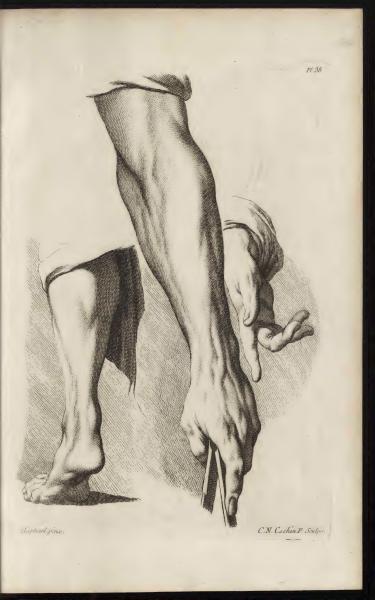 | The text labels the plate as number 38 and credits C. N. Cochin as the engraver. It serves to identify the illustration as part of an artistic study from the book focusing on human anatomy. The name 'Leopard Rose' is also mentioned, possibly related to the plate or artist. |
| Jombert - Method - Page 206 |  | |
| Jombert - Method - Page 207 |  | |
| Jombert - Method - Page 208 |  | This page contains a sketch labeled "Plate 41" created by Cochin. The drawing serves as an artistic representation and study of human anatomy. |
| Jombert - Method - Page 209 |  | The text identifies the image as Plate 42 and credits the creation to C. N. Cochin, who painted and engraved it. It is part of a historic book about drawing that includes detailed studies of the human figure. |
| Jombert - Method - Page 210 |  | The text on the page is simply a caption reading 'Plate 43', indicating the sequence of this illustration in a series. It aligns with the book's format of providing numbered illustrations for educational purposes. |
| Jombert - Method - Page 211 |  | The image is labeled as Plate 44 and is credited to Cochin, who painted, delineated, and engraved it. The illustration is a detailed study of a male figure. |
| Jombert - Method - Page 212 |  | The text indicates this is "Plate 45," drawn and engraved by Cochin the Younger. The engraving is part of a collection showcasing detailed anatomical studies. |
| Jombert - Method - Page 213 |  | The text in the image simply denotes the plate number, "Plate 46." It refers to the illustrations within a book on the art of drawing. It does not contain additional descriptive information beyond the plate number. |
| Jombert - Method - Page 214 |  | This is an illustration labeled "Plate 47," possibly denoting a sequence from the book. It references names or terms possibly related to anatomical or artistic figures, though precise interpretation requires context. |
| Jombert - Method - Page 215 |  | The text denotes this as the fourth plate, drawn by C. Cochin. It specifies the artist responsible for the illustration on the page. |
| Jombert - Method - Page 216 |  | The text identifies the illustration as "Plate 49" and credits Cochin as the artist responsible for painting, drawing, and sculpting the piece. The artwork showcases a classic example of academic figure drawing aimed at studying human anatomy. |
| Jombert - Method - Page 217 |  | N. Cochin drew and engraved the image on Plate 60. It serves as an example of anatomical drawing for educational purposes in the context of the book. The text is minimal and mainly credits the artist while identifying the plate number. |
| Jombert - Method - Page 218 |  | The image contains a labeled plate, "Plate 51," featuring a detailed drawing of a male figure. This art style fits the instructional nature of the book on human anatomy and drawing techniques. |
| Jombert - Method - Page 219 |  | The text describes Plate 52 of the book with an image drawn and engraved by Cochin the Younger, highlighting the artistry involved in rendering the human form. |
| Jombert - Method - Page 220 |  | The text describes an artwork titled "Death of the Lord," drawn by Cochin. It mentions that the artwork has not yet been removed. |
| Jombert - Method - Page 221 |  | The text provides a brief description or commentary accompanying anatomical illustrations. It emphasizes enduring aspects of depicted human forms. The annotations likely refer to details within the anatomical studies. |
| Jombert - Method - Page 222 |  | The text labels the illustrations as plates 56 and 55, likely referring to figures illustrating anatomical details relevant to drawing education. These labels indicate sequence in a series from an instructional book on drawing and anatomy. |
| Jombert - Method - Page 223 |  | The text indicates that the illustrations depict measurements of the 'Commode Hercules,' a classical reference. It appears to focus on anatomical precision and proportions in art. The page likely serves educational purposes for artists studying human anatomy. |
| Jombert - Method - Page 224 |  | The image provides annotated illustrations of the Venus de' Medici, both from the front and back. These notes are likely aiding in understanding proportion and anatomy in drawing. They serve as instructional guides for artists learning to depict the human figure. |
| Jombert - Method - Page 225 |  | The text identifies two plates: one depicting multiple views of the "Venus of Medici" and another focusing on detailed studies of the feet of this figure. These illustrations are likely used to teach drawing and anatomical proportions. The plates are part of a historical book on art and drawing techniques. |
| Jombert - Method - Page 226 |  | The text identifies two illustrated plates: Plate 59 featuring 'Number IV Tachinoro,' possibly a classical statue, and Plate 60 displaying a portrait of a woman. These artworks represent classical sculptures and head studies. |
| Jombert - Method - Page 227 | 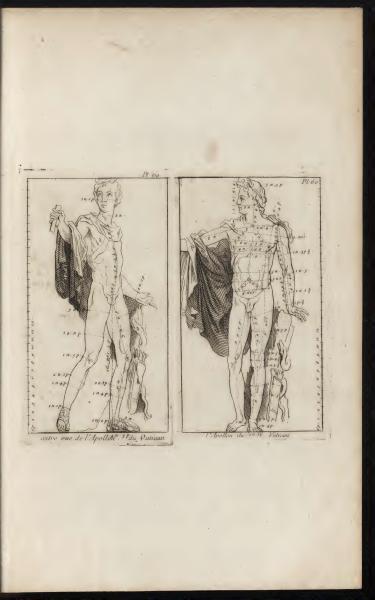 | The text identifies and describes illustrations of the Apollo statue from the Vatican. One image provides an additional view, while the other is simply referred to as the Vatican Apollo. Each figure supports the educational focus on anatomical studies for artists. |
| Jombert - Method - Page 228 | 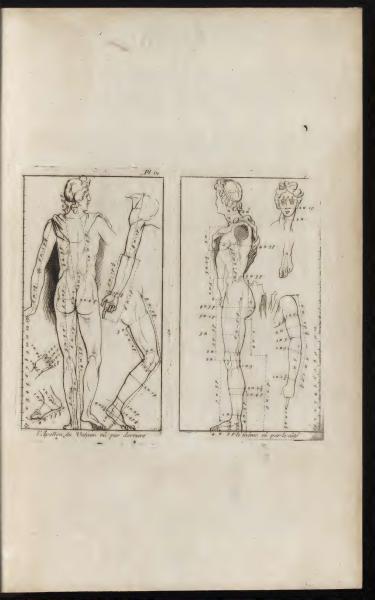 | The page features illustrations of "The Apollo of the Vatican" from different angles, with accompanying annotations. These figures serve as instructional models for understanding classical human anatomy. The text indicates the perspectives from which these statues are drawn. |
| Jombert - Method - Page 229 |  | The text labels the figures as "Athletes or Man" and "Atlantide." These terms suggest a reference to the studied human form or an idealized anatomical figure. The accompanying illustrations enhance the explanation by providing visual representation of human anatomy and proportions as studied in classical art. |
| Jombert - Method - Page 230 |  | The page features anatomical drawings showcasing the foot and side profiles of human figures, marked with labels and measurements. These illustrations are likely intended as a guide for artists studying human anatomy and proportions. |
| Jombert - Method - Page 231 |  | The text identifies the figures in the drawing as Venus, Apollo, and Antinous, classical figures often used in historical anatomical studies to illustrate human proportions. This serves as a guide in the study of human anatomy for artists. |
| Jombert - Method - Page 232 |  | The page features an illustration of Laocoon, with text related to anatomical measurements, specifically the nose sizes of Laocoon and a child. The text provides a study of proportions in classical sculpture. |
| Jombert - Method - Page 233 | 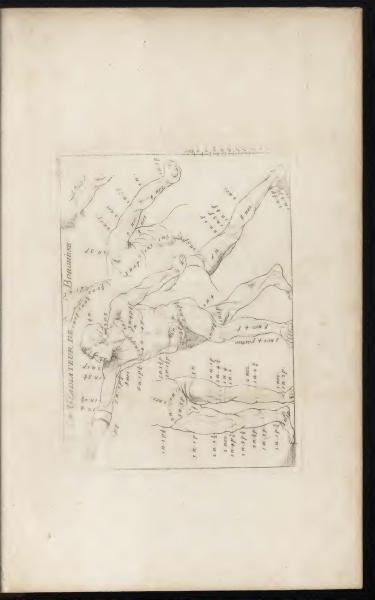 | The text annotates a drawing of the Borghese Gladiator, detailing measurements in old French units. These measurements serve as a guide for artists to accurately capture human proportions. The notes aid in studying and mastering Renaissance-style anatomical drawings. |
| Jombert - Method - Page 234 |  | |
| Jombert - Method - Page 235 |  | The text describes two engravings: one is a detailed depiction of a gladiator's head, and the other is a retouched image of an ancient gladiator in a dynamic pose. These images are likely from a book focused on aiding artists in understanding the human form. |
| Jombert - Method - Page 236 |  | The page features illustrations labeled "Foot of the Gladiator" with measurements. It provides anatomical studies of the human form, likely for educational purposes in drawing and anatomy. The labels and measurements suggest a focus on proportions and classical ideals. |
| Jombert - Method - Page 237 |  | The text consists of titles "The Borghese Faun" and "The Faun," accompanying illustrations of faun figures that include annotated measurements to instruct on anatomy and proportions. These serve as educational tools for learning accurate figure drawing based on classical art models. |
| Jombert - Method - Page 238 |  | The text provides measurements and annotations for two anatomical sketches titled 'Foot of the Faun of Borghese' and 'The Faun of Borghese'. It includes detailed artistic measurements and parts of the body aimed to educate on correct proportions. These are part of instructional plates from a book teaching drawing techniques. |
| Jombert - Method - Page 239 |  | The page contains illustrations depicting various parts of a child's body with annotations related to proportions. These images are meant for educational purposes, focusing on teaching anatomical accuracy. The text refers to these studies as parts of the child from the "Bath of Boylder." |
| Jombert - Method - Page 240 | 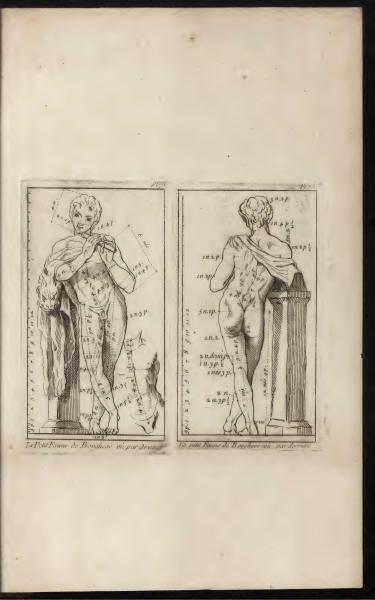 | The text describes two views of the "Small Faun of Borghese," one from the front and the other from behind. These images are likely used for teaching purposes in the context of anatomy and artistic proportions. |
| Jombert - Method - Page 241 |  | The page includes illustrations of hands and a faun figure, with annotations in French indicating measurements and drawing guidelines. These annotations offer insights into artistic methodologies for rendering anatomical details. The text suggests that parts like the nose are divided for precise drawing techniques. |
| Jombert - Method - Page 242 |  | The image features anatomical drawings of a figure referred to as 'Murmillo,' showing another view and providing proportions. It includes two labeled illustrations highlighting the anatomical structure and measurements. The text specifies that the figure is seven and a half heads tall, a classical way of describing proportions in art. |
| Jombert - Method - Page 243 |  | The text identifies the subjects of the illustrations as "Apollo from the Villa Ludovisi" and notes the use of an "Egyptian measure." The plates focus on depicting anatomical proportions of classical figures for instructional purposes in art. |
| Jombert - Method - Page 244 |  | The text indicates the subject of the engravings as the Hermaphrodite of Borghese. This refers to a well-known ancient sculpture, and the page provides illustrations that emphasize its artistic and anatomical significance. |
| Jombert - Method - Page 245 |  | The text labels two figures: an 'Ancient Satyr of the Ludovisi Villa' and an 'Ancient Egyptian Figure at the Capitoline.' These annotations likely correspond to educational illustrations for studying anatomy and classical art forms. |
| Jombert - Method - Page 246 | 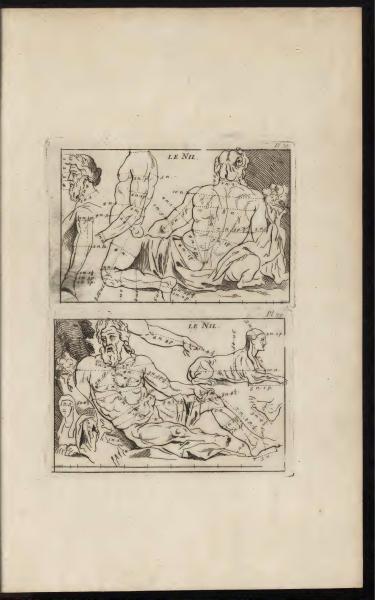 | The page features the title "The Nile" and a plate number 70. It is accompanied by two detailed drawings depicting reclining muscular figures, with annotations suggesting an emphasis on anatomical study and measurements. These illustrations are part of a broader educational effort to teach drawing using classical references and examples. |
| Jombert - Method - Page 247 |  | The text provides descriptions of the views in the horse illustrations, noting angles and perspectives. It serves to guide the reader in understanding the anatomical studies depicted. |
| Jombert - Method - Page 248 |  | The page features illustrations depicting the Battle of Fontenoy, a significant historical battle. The top image captures the movement and intensity of the battle scene with soldiers and horses. The lower illustration includes cherubic figures amidst clouds, enhancing the artistic narrative with allegorical elements. |
| Jombert - Method - Page 249 |  | The text denotes plate number 82 and credits C.N. Cochin for the invention, drawing, and engraving of the images. Cochin is recognized for both the artistic design and the engraving work on this page. |
COPYRIGHT © 2024 STUDY DRAWING. ALL RIGHTS RESERVED.